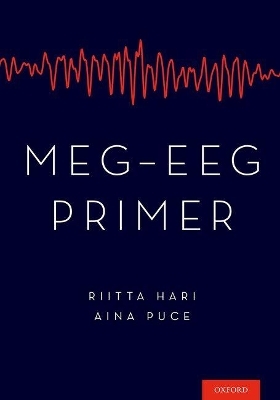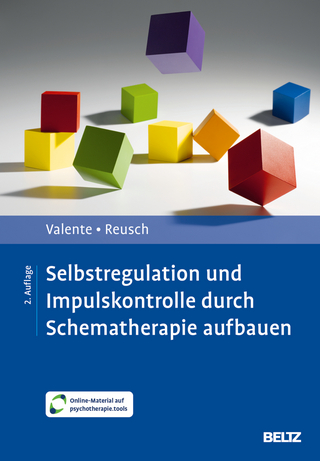
MEG-EEG Primer
Oxford University Press Inc (Verlag)
978-0-19-049777-4 (ISBN)
- Jointly written by two authors, providing a cohesive and unified voice;
- First-ever volume to address these two closely related methods side-by-side, starting from their physical and physiological bases and then advancing to methods of data acquisition, analysis, visualization, and interpretation;
- Presents strengths and weaknesses of MEG and EEG relative to each other and to other existing methods used in systems and cognitive neuroscience;
- Looks to future developments in equipment design, and experimentation; and
- Provides a thorough examination of previous literature on MEG and EEG.
Magnetoencephalography (MEG) and electroencephalography (EEG) provide complementary views to the neurodynamics of healthy and diseased human brains. Both methods are totally noninvasive and can track with millisecond temporal resolution spontaneous brain activity, evoked responses to various sensory stimuli, as well as signals associated with the performance of motor, cognitive and affective tasks.
MEG records the magnetic fields, and EEG the potentials associated with the same neuronal currents, which however are differentially weighted due to the physical and physiological differences between the methods. MEG is rather selective to activity in the walls of cortical folds, whereas EEG senses currents from the cortex (and brain) more widely, making it harder to pinpoint the locations of the source currents in the brain. Another important difference between the methods is that skull and scalp dampen and smear EEG signals, but do not affect MEG. Hence, to fully understand brain function, information from MEG and EEG should be combined.
Additionally, the excellent neurodynamical information these two methods provide can be merged with data from other brain-imaging methods, especially functional magnetic resonance imaging where spatial resolution is a major strength.
»MEG-EEG Primer« is the first-ever volume to introduce and discuss MEG and EEG in a balanced manner side-by-side, starting from their physical and physiological bases and then advancing to methods of data acquisition, analysis, visualization, and interpretation.
The authors pay special attention to careful experimentation, guiding readers to differentiate brain signals from various artifacts and to assure that the collected data are reliable. The book weighs the strengths and weaknesses of MEG and EEG relative to one another and to other methods used in systems, cognitive, and social neuroscience. The authors also discuss the role of MEG and EEG in the assessment of brain function in various clinical disorders. The book aims to bring members of multidisciplinary research teams onto equal footing so that they can contribute to different aspects of MEG and EEG research and to be able to participate in future developments in the field.
Riitta Hari MD, PhD researches systems neuroscience and neuroimaging. She has pioneered the use of MEG in the study of the spatiotemporal dynamics of sensory, motor, cognitive and social brain functions both in health and disease. Her background training is in medicine, with specialization in clinical neurophysiology.
Aina Puce, PhD is a social neuroscientist with research interests in the brain bases of human non-verbal communication. Her studies in basic and clinical human neuroscience have used scalp and intracranial EEG, and functional MRI methods. Her formal training was in biophysics and functional brain mapping/neurophysiology.
PREFACE
PREAMBLE
SECTION 1
CHAPTER 1: INTRODUCTION
MEG and EEG Setups
Comparison of MEG and EEG
Structure of this Primer
CHAPTER 2: INSIGHTS INTO THE HUMAN BRAIN
Overview of the Human Brain
How to Obtain Information About Brain Function
Timing in Human Behavior
Functional Structure of the Human Cerebral Cortex
Communication Between Brain Areas
Thalamocortical Connections
Intra-Brain Connectivity
Electric Signaling in Neurons
Membrane Potential
Action Potentials
Postsynaptic Potentials
CHAPTER 3: BASIC PHYSICS AND PHYSIOLOGY OF MEG AND EEG
An Overview of MEG and EEG Signal Generation
Charges and Electric Current
Ohm's and Kirchoff's Laws
Relationship Between Current and Magnetic Field
Superconductivity
Inverse Problem
Source Currents
Primary Current
Layers, Open Fields, and Closed Fields
Intracortical Cancellation
Volume Conduction
Spherical Head Model
Some General Points About Source Localization
CHAPTER 4: AN OVERVIEW OF EEG AND MEG
Historical Aspects
Early EEG Recordings
Early MEG Recordings
Brain Rhythms
Evoked and Event-Related Responses
SECTION 2
CHAPTER 5: INSTRUMENTATION FOR MEG AND EEG
EEG Instrumentation
Electrodes
EEG Amplifiers
Differential Amplifiers, Common Mode Rejection, and Amplifier Input Impedances
Standard Electrode Positions
Effects of Reference Electrode on Potential Distribution
Re-Referencing Relative to an Average Reference
MEG Instrumentation
Squids and Squid Electronics
Flux Transformers and Their Configuration
Shielding
Other Means to Maintain a Noise-Free Environment
Stimulators and Monitoring Devices
Auditory Stimulators
Visual Stimulators
Somatosensory Stimulators
Stimulators for Inducing Acute Pain
Passive-Movement Stimulators (Proprioception Stimulation)
Monitoring Devices
Future Developments of EEG and MEG Instrumentation
Developments in EEG
Developments in MEG
CHAPTER 6. PRACTICALITIES OF DATA COLLECTION
General Principles of Good Experimentation
Replicability Checks
EEG Recordings: The Practice
Electrodes, Skin Preparation, and Electrode-Impedance Measurement
Post-Recording Infection Control
MEG Recordings: The Practice
Measurement of MEG Sensor and EEG Electrode Positions
Locations of MEG Sensors and EEG Electrodes
Electrical Safety
CHAPTER 7: DATA ACQUISITION AND PREPROCESSING
Filtering
Data Sampling (Analog-To-Digital Conversion)
CHAPTER 8: ARTIFACTS
General
Artifact-Removal Methods
Blind Source Separation and Independent-Component Analysis
Signal-Space Projection (SSP) and Temporal Signal-Space Separation Tsss (For MEG)
Eye-Related Artifacts
Generation and Recognition of Eye Movement and Eye Blink Artifacts
Saccadic and Microsaccade Artifacts
Electroretinogram and Magnetoretinogram
Removal of Eye-Related Artifacts
Muscle Artifacts
Generation and Recognition
Removal
Cardiac Artifacts
Generation and Recognition
Removal
Respiration-Related Artifacts
Generation and Recognition
Sweating
Generation, Recognition, and Removal
Non-Physiological Artifacts
Power-Line Noise and its Removal
Response-Box Artifacts
EEG-Electrode and MEG-Sensor-Related Artifacts
How to be Sure that the Signals come from the Brain
CHAPTER 9: ANALYZING THE DATA
General
Data Inspection and Pre-Processing
Signal Averaging of MEG/EEG Data
Signal-To-Noise Considerations
Segmentation
Amplitude and Latency Measures
Issues Related to Cross-Group Averaging and Assessment of Group Differences
Topographic Maps of EEG and MEG Activity
Whole-Head Statistical Analysis of EEG Data
Analysis of Spontaneous Activity and Single-Trial Data
General
Evoked Versus Induced Activity
MEG/EEG Signal Level and Power
Event-Related Desynchronization and Synchronization, and Temporal Spectral Evolution
Time-Frequency Analyses
Phase Resetting and Models of Evoked Activity
Coherence and Other Measures of Association
Cross-Frequency Coupling
Global Field Power, Dissimilarity, and Brain Microstates
Source Modeling
The Forward and Inverse Problems in MEG and EEG
Head Models
Single-Dipole Model and Model Validity
Goodness-of-Fit and Confidence Limits of the Model
Spatial Resolution
Source Extent
Multidipole Models, Distributed Models, and Beamformers
Hypothesis Testing with Predetermined Source Locations
Effect of Synchrony
Changes in Orientation/Tilting
Assessments of Effective Connectivity
Common Pitfalls in Data Analysis and Interpretation
Interpretation of MEG/EEG Data
SECTION 3
CHAPTER 10: BRAIN RHYTHMS
General
Alpha Rhythm of the Posterior Cortex
Mu Rhythm of the Sensorimotor Cortex
Tau Rhythm in the Auditory Cortex
Beta Rhythm
Theta Rhythm
Gamma Rhythms
Delta-Band Activity and Ultra-Slow Oscillations
Coupling Between Different Brain Rhythms
Changes in Brain Rhythms During Sleep
Effects of Anesthesia and Other Drugs on EEG/MEG
CHAPTER 11: EVOKED AND EVENT-RELATED RESPONSES
General
An Initial Example
Nomenclature of Evoked Responses and Brain Rhythms
Effects of Interstimulus Interval and Stimulus Timing
Effects of Other Stimulus Parameters
CHAPTER 12: AUDITORY RESPONSES
Aspects of Auditory Stimulation
Auditory Brainstem Responses
Middle-Latency Auditory-Evoked Responses
Long-Latency Auditory Evoked Responses
Auditory Steady-State Responses
Frequency Tagging
CHAPTER 13: VISUAL RESPONSES
Visual Stimuli
Transient Visual Responses
Assessing the Ventral Visual Stream
Assessing the Dorsal Visual Stream
Steady-State Visual Responses
CHAPTER 14: SOMATOSENSORY RESPONSES 304
Compound Action Potentials and Fields of Peripheral Nerves
Responses from SI Cortex
Responses from Posterior Parietal Cortex
Responses from SII Cortex
Somatosensory Steady-State Responses
High-Frequency Oscillations (Hfos) in SI
Pain and Nociceptive Responses
CHAPTER 15: OTHER SENSORY RESPONSES & MULTISENSORY INTERACTIONS
Visceral Responses
Olfactory and Gustatory Responses
Multisensory Interaction
General
Audiotactile Interaction: An MEG Case Study
Multisensory Integration of Human Communication
Multisensory Integration Reflected in Spontaneous MEG/EEG Activity
CHAPTER 16: MOTOR FUNCTION
Movement-Related Readiness Potentials and Fields
Coherence Between Brain Activity and Movements/Muscles
General
Cortex-Muscle Coherence
Corticokinematic Coherence
Corticovocal Coherence
CHAPTER 17: BRAIN SIGNALS RELATED TO CHANGE DETECTION
General
Contingent Negative Variation (CNV)
Mismatch Negativity and Field (MMN, MMF)
P300 Responses
N400 Responses
Error-Related Negativity (ERN)
CHAPTER 18: THE SOCIAL BRAIN
Theoretical Framework
Responses to Emotions Depicted by Faces and Bodies
Action Viewing and Mirroring
Hyperscanning
Verbal Communication
CHAPTER 19: BRAIN DISORDERS
General Remarks
Epilepsy
Preoperative Mapping
Functional Identification of the Central Sulcus
Anatomical Identification of the Central Sulcus
Hemispheric Dominance for Speech and Language
Stroke
Critically Ill Patients
Coma
Brain Death
CHAPTER 20: MEG/EEG IN THE STUDY OF BRAIN FUNCTION
Advantages of MEG and EEG
Disadvantages of MEG and EEG
Combining MEG and EEG
Combining MEG/EEG with MRI/fMRI
EEG During Non-Invasive Brain Stimulation
CHAPTER 21: LOOKING TO THE FUTURE
Decoding of Brain States
Travelling Light
Data Governance
Better Analysis of Behavior
Modeling at Different Levels
How Your MEG and EEG Work Can Make an Impact on Science
Index
"This Primer fulfills a gap in the human neurophysiology literature where no book exists dealing with MEG and EEG in equal terms. This is important since both methodologies are, in essence, complementary and jointly can be used to answer specific scientific questions with respect to a variety of brain functions. Special attention is paid to comparisons of findings obtained using both MEG and EEG modalities, what can yield important new insights, particularly in the growing field of cognitive neuroscience. Written in an appealing style, this Primer embraces the whole field of human neurophysiology." -Fernando Lopes Da Silva, MD, PhD, Emeritus Professor, Center of Neuroscience, Swammerdam Institute for Life Sciences, Amsterdam, The Netherlands "
| Erscheinungsdatum | 07.05.2017 |
|---|---|
| Verlagsort | New York |
| Sprache | englisch |
| Maße | 177 x 251 mm |
| Gewicht | 712 g |
| Einbandart | kartoniert |
| Themenwelt | Geisteswissenschaften ► Psychologie ► Verhaltenstherapie |
| Medizin / Pharmazie ► Medizinische Fachgebiete ► Neurologie | |
| Medizin / Pharmazie ► Medizinische Fachgebiete ► Psychiatrie / Psychotherapie | |
| Medizin / Pharmazie ► Medizinische Fachgebiete ► Radiologie / Bildgebende Verfahren | |
| Schlagworte | EEG • Elektroencephalogramm (EEG) |
| ISBN-10 | 0-19-049777-7 / 0190497777 |
| ISBN-13 | 978-0-19-049777-4 / 9780190497774 |
| Zustand | Neuware |
| Informationen gemäß Produktsicherheitsverordnung (GPSR) | |
| Haben Sie eine Frage zum Produkt? |
aus dem Bereich


